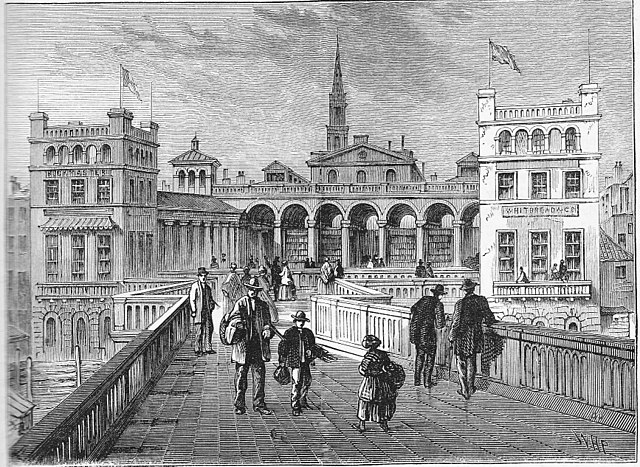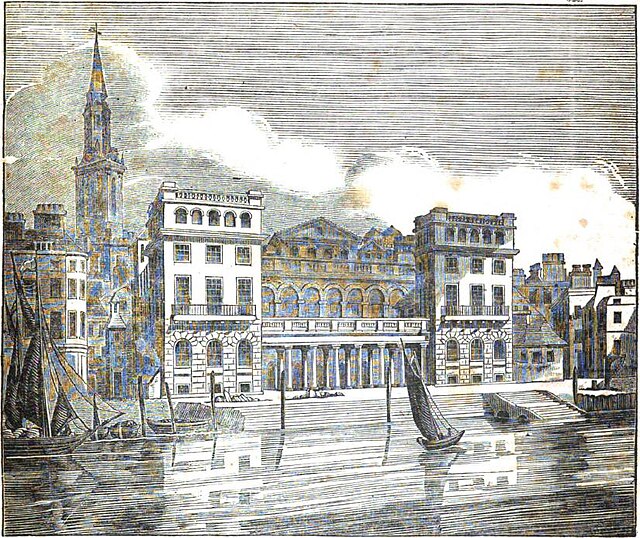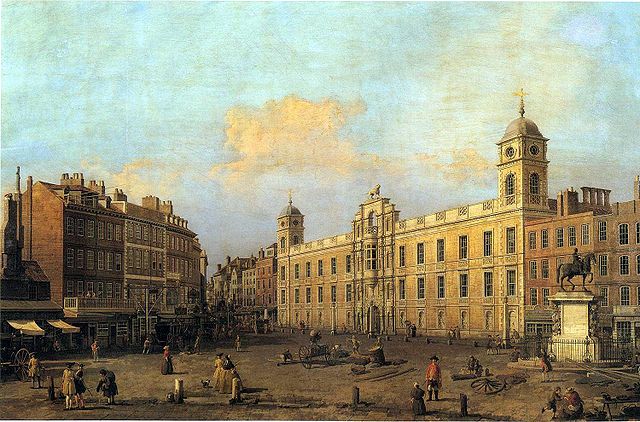Hungerford Market was a produce market in London, at Charing Cross on the Strand. It existed in two different buildings on the same site, the first built in 1682, the second in 1832. The market was first built on the site of Hungerford House, next to Durham Yard, the town house of the Hungerford family. The house had burned down in 1669 as is recorded in the Diary of Samuel Pepys. It was replaced by a new Italianate market building by Charles Fowler, which opened in 1833. The new market was unsuccessful. It was damaged when the adjoining Hungerford Hall burned down in 1854, and was sold to the South Eastern Railway in 1862. Charing Cross railway station was built on the site and opened in 1864.
"Hungerford Market, from the bridge, in 1850". Engraving by "WHP" published in Edward Walford's "Old and New London", 1878. New Hungerford Market, built circa 1832, viewed from Hungerford Bridge. The Church of St Martins-in-the-Field is visible in the background
New Hungerford Market, River Thames front, view before the building of Hungerford Bridge
"Old Hungerford Market (from a view published in 1805)". The bust of Sir Edward Hungerford (d.1711) is visible set high into the north wall. Engraving by R.C. West, 1805, published in Edward Walford's "Old and New London", 1878
Charing Cross is a junction in Westminster, London, England, where six routes meet. Since the early 19th century, Charing Cross has been the notional "centre of London" and became the point from which distances from London are measured. Clockwise from north, the routes that meet at Charing Cross are: the east side of Trafalgar Square leading to St Martin's Place and then Charing Cross Road; the Strand leading to the City; Northumberland Avenue leading to the Thames Embankment; Whitehall leading to Parliament Square; The Mall leading to Admiralty Arch and Buckingham Palace; and two short roads leading to Pall Mall.
Charing Cross roundabout, with a Statue of Charles I on the site of the original Eleanor Cross in the then hamlet of Charing, an important junction since the middle ages.
The old Eleanor cross at Charing (c. 1293 to 1643)
Frontage onto Strand/Charing Cross of Northumberland House in 1752 by Canaletto. The statue of Charles I is at the right of the painting. At the left is the Golden Cross Inn, with signboard outside.
The Victorian replacement of the original Eleanor Cross 200 metres (200 yards) away, along the Strand in front of Charing Cross Station/Hotel. The area derives its name from the original monument destroyed by Parliament in the 1600s; the memorial replacement dates from the 1800s.







